GPT-5 just dropped: Here’s what it means for your visibility in AI answers
No, GPT-5 isn’t AGI. And no, it didn’t delete human users from the marketing funnel either.
Yesterday’s playbook still matters. Traditional SEO still works. Backlinks didn’t vanish. Organic SERP traffic is alive and well.
But AI search isn’t some fringe experiment anymore. Even before GPT-5, 71.5% of users were already using AI tools for search; 14% of them daily.
That’s not edge-case behavior. That’s early mass adoption.
So what did OpenAI actually unleash?
A single, unified ChatGPT that blends agentic capabilities, o3’s advanced reasoning, 4.5’s gift of gab, 4o’s multimodality, and pretty much every other trick the old models had. Only now it’s faster, sharper, and a lot harder to stump.
What this shift means for visibility
This isn’t a Google killer. It’s a parallel system that quietly reroutes user intent before it ever hits the SERP.
GPT-5’s influence is still subtle, but growing. And as the model gets smarter, it gets more selective about the sources it pulls and the recommendations it makes.
So what does that look like in practice?
OpenAI’s benchmark scores paint a clear picture. Let’s break them down to see just how choosy Altman’s flagship model really is.
SWE-Bench Verified: 74.9% Accuracy—Why technical content matters
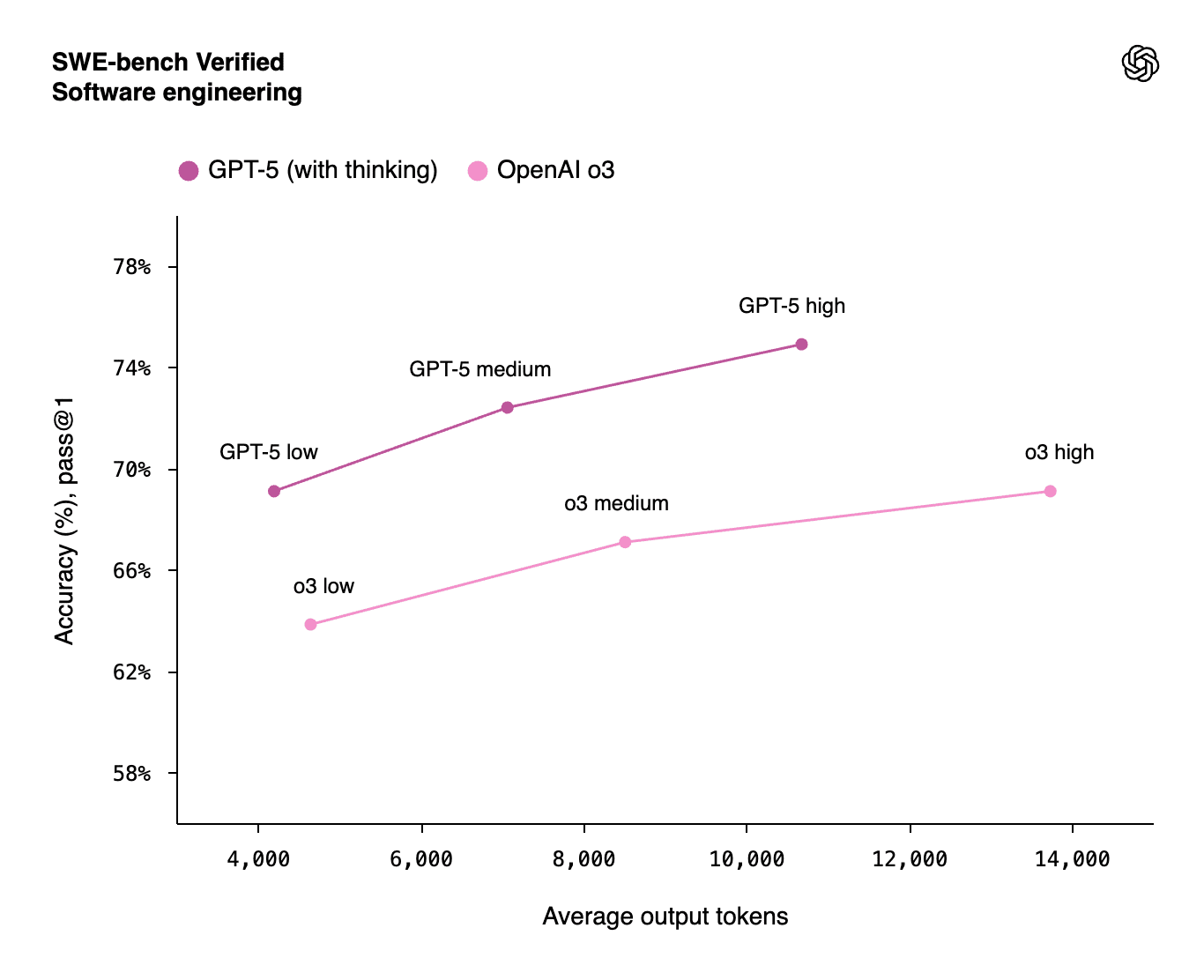
This benchmark tests AI’s ability to understand and fix software engineering issues. In plainspeak? It’s a problem-solving beast. GPT-5 high’s 74.9% score is a non-trivial leap from o3 high’s less than 70%.
Why SEOs should care. GPT-5 is better at handling complex problem-solving tasks. That means it prioritizes technically sound, solution-oriented content that’s actually useful to users.
The strategy? Create error-free, technically savvy content. That means user (and agent)-centric solutions that AI can immediately recognize as valuable.
- To humans: Valuable means shareable.
- To AI: It means citable and mentionable.
Think how-tos on topics like structured data and schema markup. Cater to GPT-5’s improved reasoning, and it will pay dividends for visibility in AI answers.
Aider Polyglot: 88% Accuracy—Multi-format content is on the rise
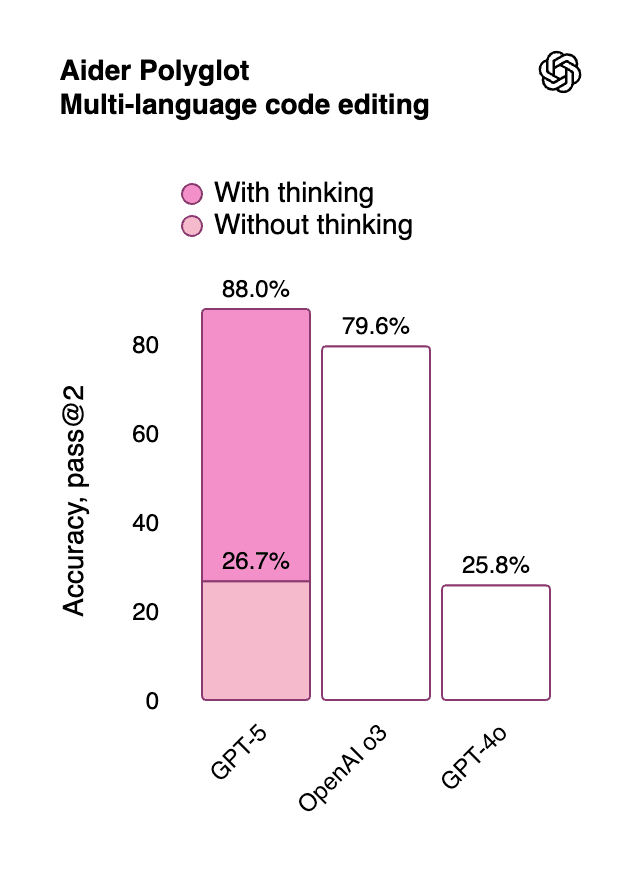
This benchmark tests GPT-5’s ability to refactor and edit code from language to language. It shows how well GPT-5 can take code written in one language (say, Python), and plug it into another (like Javascript) while preserving intent, structure, and logic. Another monumental leap from o3 to GPT-5.
Why SEOs should care. ChatGPT is getting better at parsing technical content like code, data visualization, and technical jargon. Lazy presentation is even more fatal to your visibility now because both human users and AI agents are drawn to websites with diverse content formats.
GPT-5’s Agent Mode, much like most human users, prefers modern, dynamic sites.
- But humans just want to navigate them (without friction).
- GPT-5’s Agent Mode processes and reformats them.
And since GPT-5 can navigate the SERP to benefit users, you want your content to be first on its radar.
The straightforward strategy? Don’t skimp out on multi-format content. Writing blog posts isn’t enough. Think in:
- Code snippets
- Charts
- Transcripts
- Images
- Diagrams
- JSON tables
- Explainer videos
If you have a lot of old, static but evergreen content that’s just sitting there, update and repurpose it for better AI agent accessibility.
And avoid overemphasizing keywords in your SEO strategy. Stop and think, “Is my content actually useful to users? Do they even enjoy my content?”
Because if not, GPT-5 won’t like it either. No amount of “optimized” metadata can save you from getting ignored by AI, especially if your content doesn’t resonate with users. The consequence is fewer sources or mentions in AI answers.
Tau²-Bench Telecom: 96.7% Accuracy—Time to start optimizing for multi-step queries
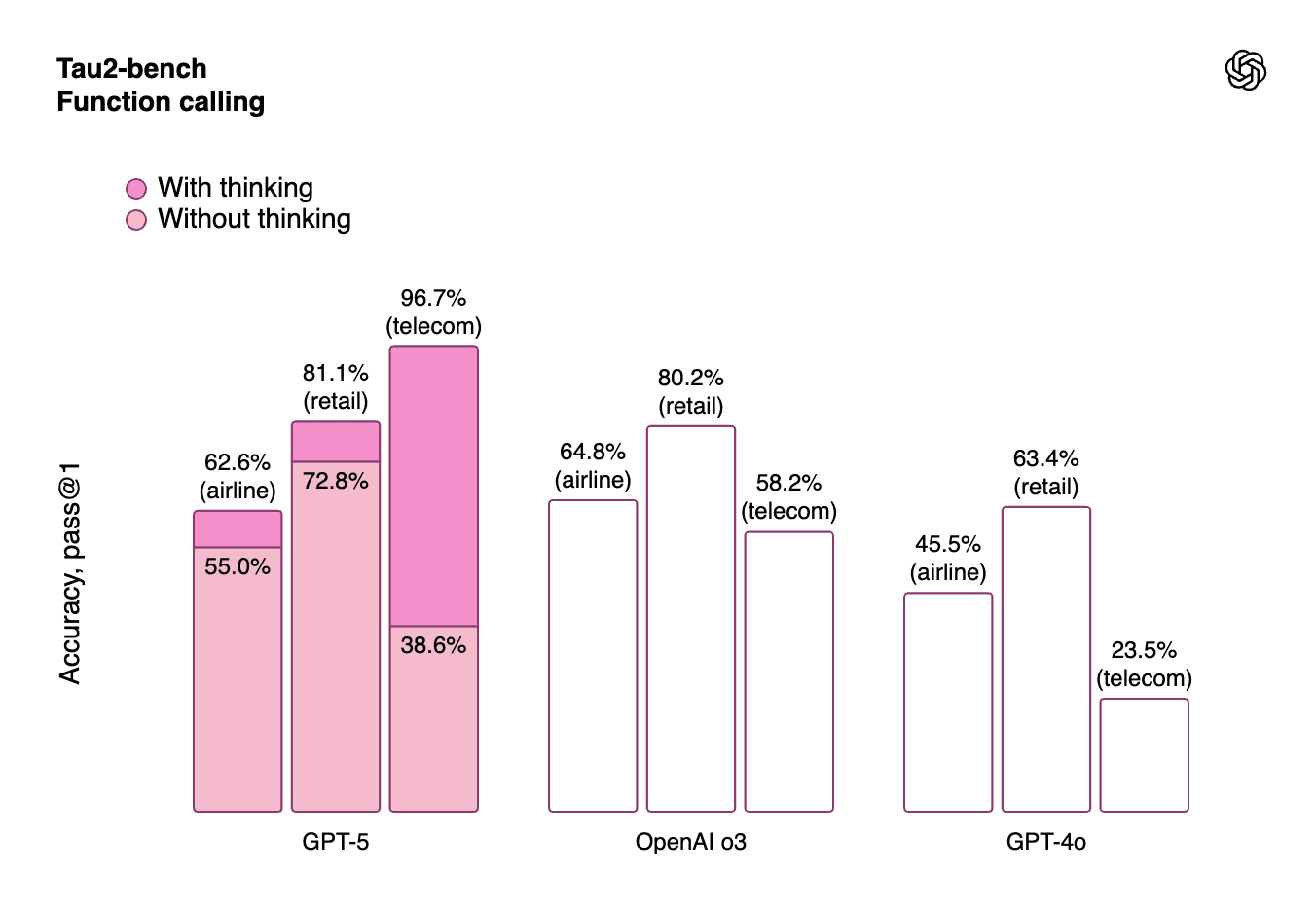
This benchmark tests GPT-5’s ability to perform complex, multi-step tasks with tool usage. GPT-5’s success with ‘thinking’ mode turned on showed it outclassing OpenAI’s o3 and 4o models in the airline, retail, and telecom industries.
Why SEOs should care. GPT-5 is superior to previous models at interpreting complex queries and giving multi-step answers that actually help users. If you want GPT-5 to pull your content, it needs to address more layered, in-depth queries.
Mike King refers to this process as query fan-out. Think query hierarchies. If you can answer the most difficult questions, then you can predict follow-ups. Which means you should also be answering those follow-ups.
The strategy? Optimize for long-tail, conversational queries. Answer questions deeply. Provide step-by-step explanations. Take advantage of FAQs where it will serve users, and optimize for SERP features like structured snippets and answer boxes. Anna Postol covers this nicely in her article about winning rich snippets.
BrowseComp Agentic search & browsing—The AI user has arrived
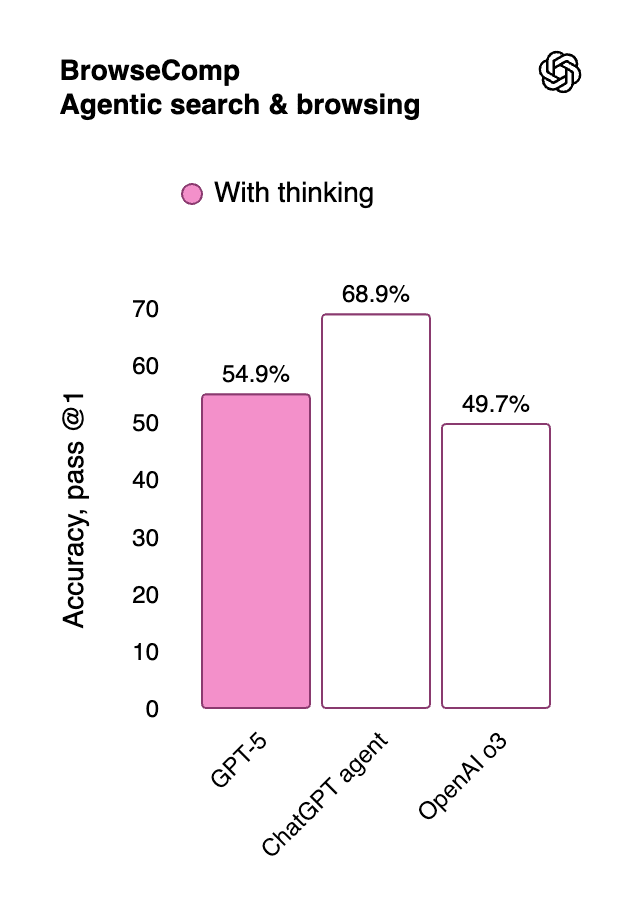
ChatGPT Agent eclipsed GPT-5 in web browsing. But both new models show a noticeable improvement over o3, OpenAI’s previous flagship model for web browsing.
- GPT-5’s 5% jump from o3 isn’t trivial.
- ChatGPT Agent’s greater than 15% jump shows what happens when OpenAI narrows its focus to semi-autonomous search.
So think of GPT-5 as the generalist, and ChatGPT Agent as the specialist that focuses on web search and performs multi-step tasks on your behalf.
Why SEOs should care. SEOs need to watch closely as GPT-5’s agentic capabilities become more reliable. If more people outsource product and service exploration to agents (and more often), you’ve got an entire population of AI consumers to optimize for.
The strategy? I outlined this best in my previous article about ChatGPT Agent, but here’s the brief take.
- Make forms that cater to both AI and human users.
- Think of CTAs as instructions for AI.
- Make your UX machine-friendly.
- Keep your HTML clean.
- Avoid pop-ups.
Just because your site works for users doesn’t mean it will work for agents. Start learning how to cater to AI users to get the jump on your competitors in AI search.
Humanity’s Last Exam (HLE)—Smarter AI prefer smarter content
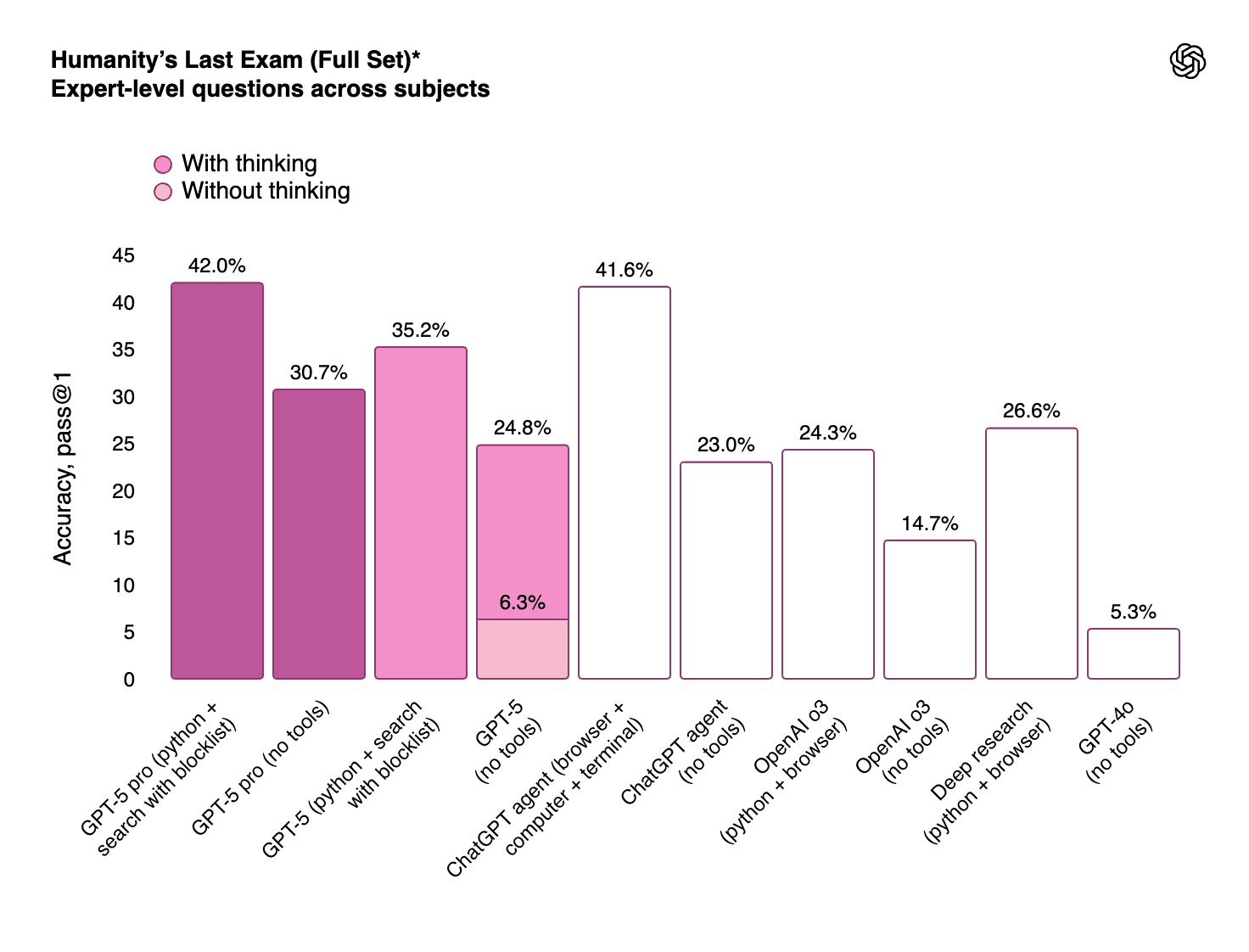
This benchmark tests GPT-5’s ability to use logic and reason to answer complex questions. Another huge win for GPT-5 and ChatGPT Agent over previous models.
Why SEOs should care. According to Sam Altman, “GPT-5 is the first time that it really feels like talking to an expert in any topic, like a PhD-level expert.”
So when an AI with web search functionality can use PhD-level reasoning to navigate a topic or issue, it prioritizes content that can reliably answer the full range of a user’s questions. It also has an advanced systemic understanding of what it would take to achieve that.
The strategy? First and foremost, don’t take Altman’s words at face value. GPT-5’s capabilities are a hot debate in the AI space right now. But at the very least, the benchmarks corroborate its greater intelligence than legacy models, so treat it accordingly. Address long-tail queries with rich, well-researched content.
And AI or no AI, always create content that adds value beyond surface-level information.
What this all boils down to
If you want to reliably appear in GPT-5’s answers, it will take more SEO ingenuity and an AI-search inclusive mindset.
To recap, stay critical and watch carefully, but take GPT-5’s benchmark performance seriously. Adapt accordingly to appear in AI answers:
- SWE-Bench Verified: Prioritize technically accurate content.
- Aider Polyglot: Create content with varied formats.
- Tau²-Bench Telecom: Optimize for multi-step queries.
- BrowseComp Agentic: Cater to both AI and human users.
- Humanity’s Last Exam: Provide contextually rich, well-researched content.
Agentic tools like GPT-5 don’t need to reach AGI status to shape the future of search. They just need to get a little smarter with each iteration. Every accuracy gain, every reasoning upgrade, makes it harder for weak content to slip through.
And since AI is only getting smarter, the stakes are getting higher. So if you don’t want to be invisible to AI now, you definitely won’t want to be later.
Bonus: Supercharge GPT‑5 SEO workflows with live data from SE Ranking
What if GPT‑5 could pull SEO insights while generating content, building strategies, or auditing websites? Now it can—thanks to SE Ranking’s MCP server, available through our API.
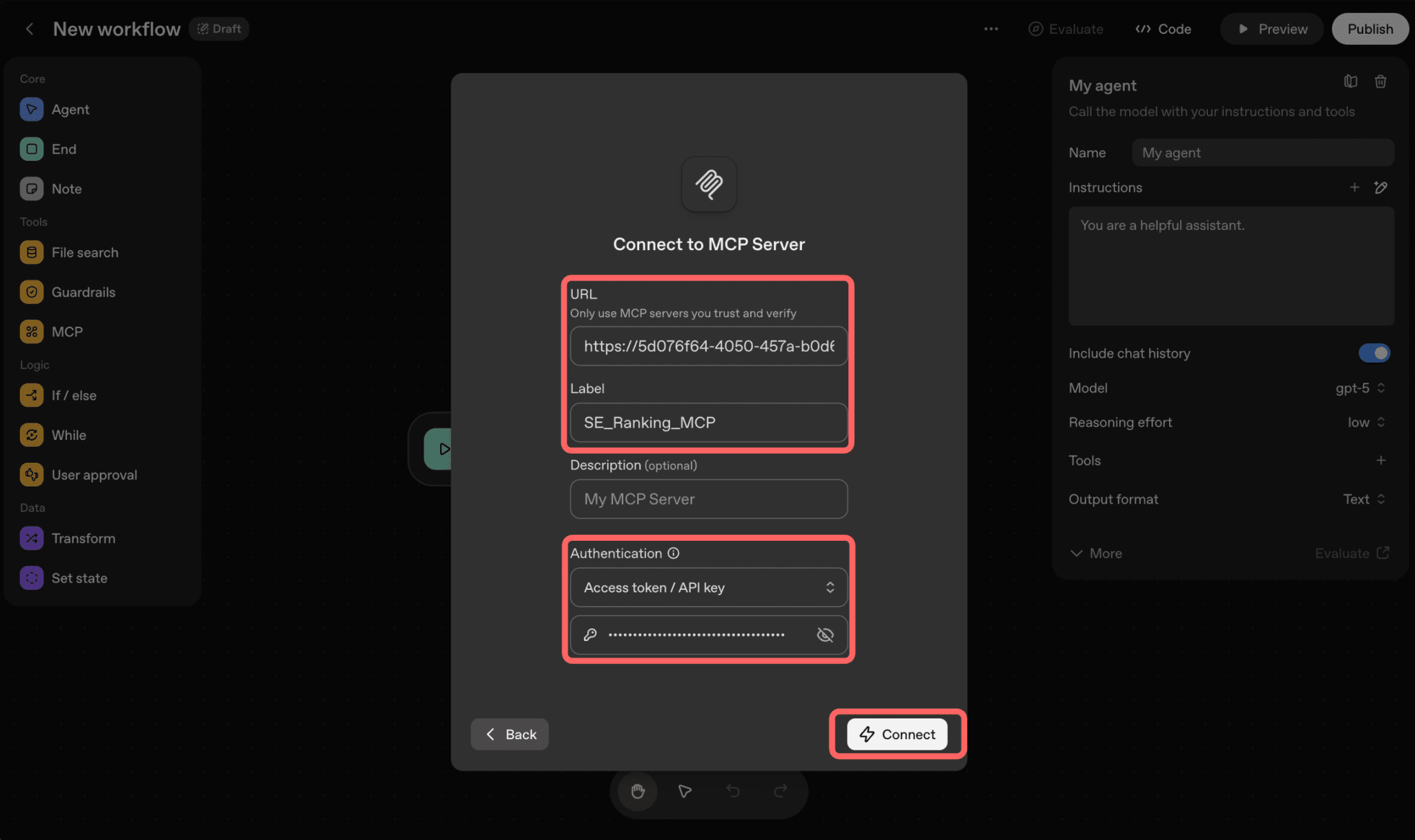
This integration lets you feed live keyword, backlink, and competitor data directly into AI assistants like ChatGPT. Just prompt your assistant with a command like:
“Get the top 10 backlinks for domain.com”
Your AI will instantly query the MCP server, fetch fresh SEO data, and use it to inform its answer—no manual exports or copy-pasting required.
Explore the MCP integration in this step-by-step guide.

